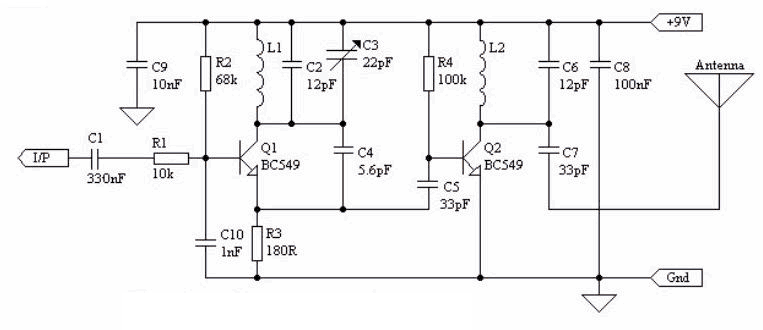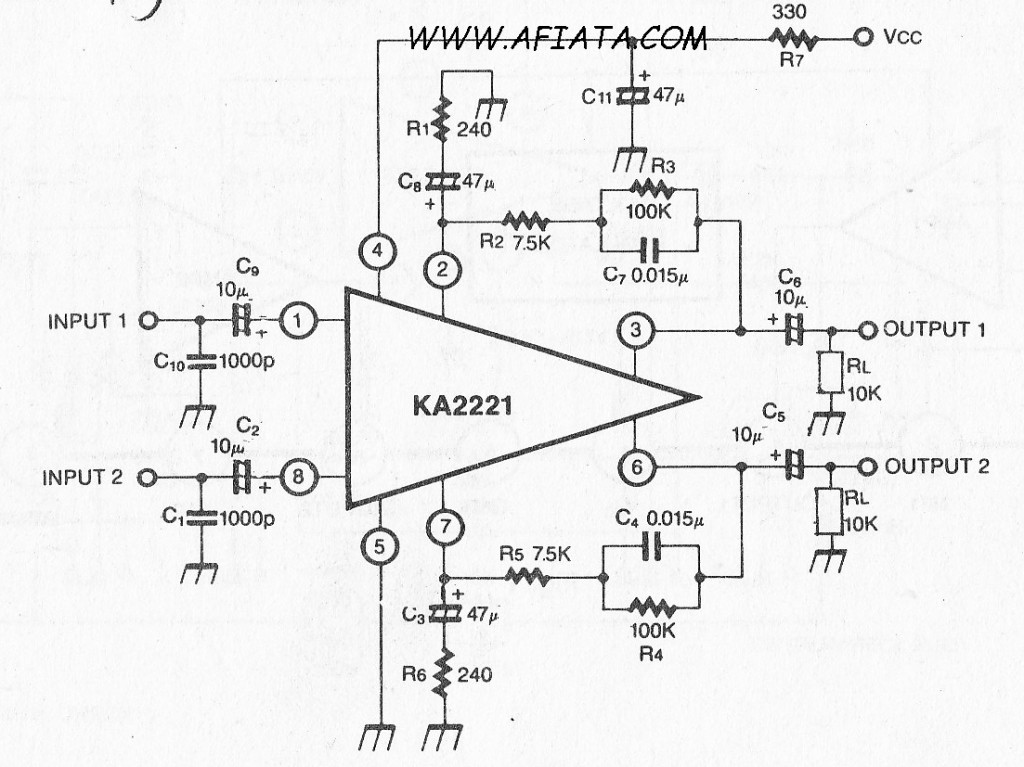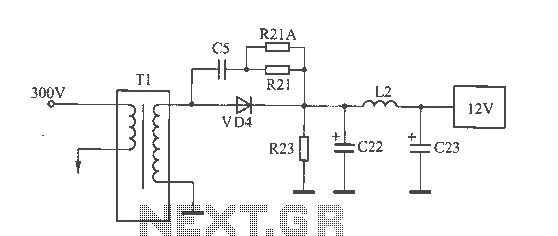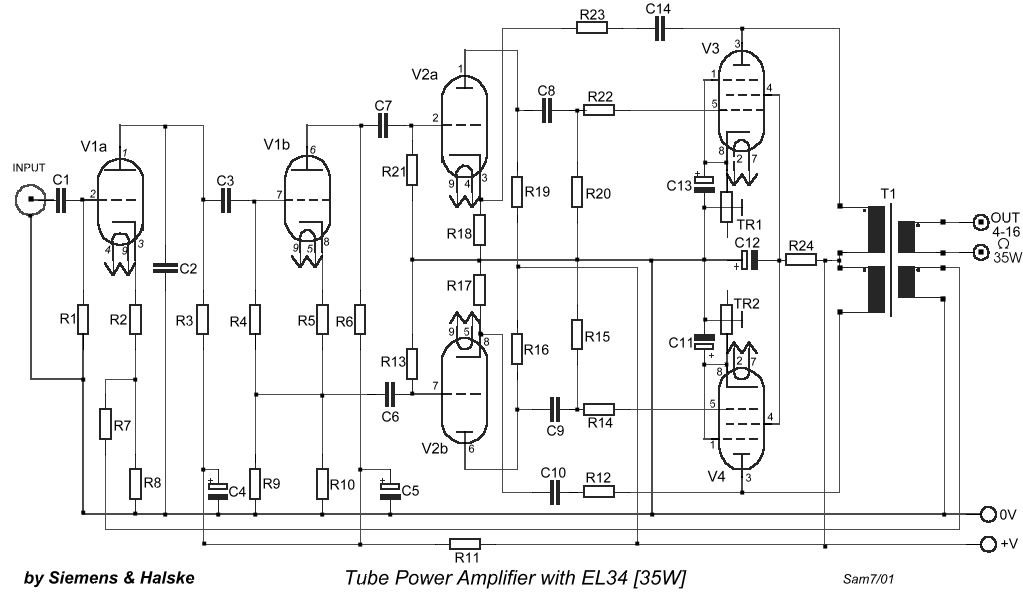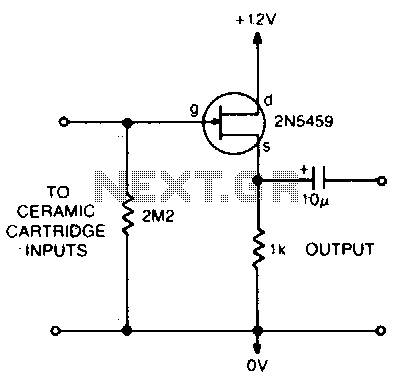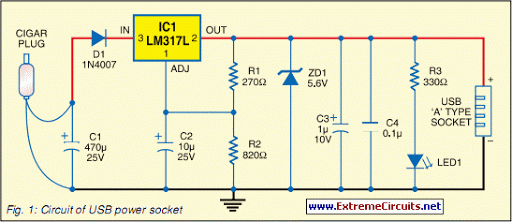
quad power supply for hybrid amplifier
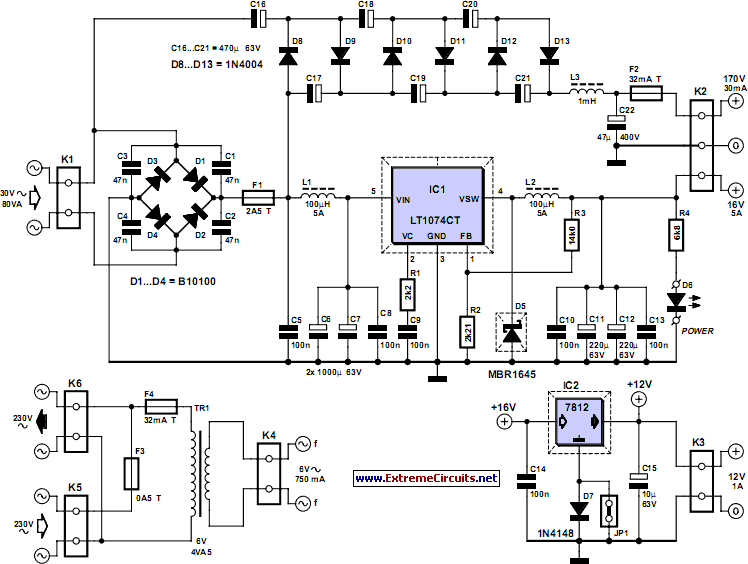
This power supply is designed for use with the Simple hybrid amplifier published in this issue, but it is also suitable for other applications. A cascade generator is used for the 170 V output, a switch-mode supply provides 16 V, a series regulator outputs 12 V, and a separate transformer supplies 6.3 V for the filaments. The circuit employs an LT1074CT (IC1) for regulation, allowing for the use of standard components and achieving high efficiency. The power loss is reduced compared to a linear voltage regulator, enabling the use of a higher transformer voltage and a smaller cascade section to generate the 170 V required for the SRPP stage in the amplifier. The lower input current results in smaller losses in the bridge rectifier (D1 to D4). A standard 12 V regulator (IC2) converts the 16 V to a stabilized voltage for the buffer stage. When using an ECC83 (12AX7) in the hybrid amplifier, this 12 V can also power the valve filaments, although 12.6 V is preferred. The valve draws about 150 mA, necessitating a heatsink for the 12 V regulator, which can be a small SK129 heatsink from Fischer (38.1 mm, 6.5 K/W). To increase the voltage by 0.6 V, diode D7 is added to the ground connection of the regulator. To obtain a 12 V output, JP1 should be closed, shorting D7. IC1 and D5 require additional cooling, for which the 63.5 mm version of the SK129 (4.5 K/W) is suitable. Both components must be mounted on opposite sides of the heatsink, ensuring electrical isolation. It is advisable to refer to the Linear Technology website for layout recommendations regarding the LT1074. Standard chokes rated at 5 A can be used for L1 and L2. To further reduce residual 100 kHz switching frequency, an extra LC filter can be added at the output. The bridge rectifier diodes are B10100 Schottky rectifiers, chosen for their low forward voltage drop (0.7 to 0.8 V at 10 A) and a reverse voltage rating of 100 V, allowing for the option of using an LT1074HVCT, which can handle input voltages up to 60 V, enabling a 40 VAC transformer. The same cascade circuit can produce 220 VDC easily. The LT1074CT can manage up to 45 V, thus operating close to its specifications in this circuit. A cascade circuit generates the high tension (HT) supply for the valve, although a separate transformer with a bridge rectifier and smoothing capacitor could also be used. However, sourcing a 4.5 VA transformer with a 40 V secondary is challenging, leading to the decision to use an 80 VA transformer for the cascade generator. The capacitors in the cascade circuit are sized larger than necessary to simplify the calculation of the expected output voltage, estimated at nearly 170 V for no-load conditions. L3 and C22 filter out high-frequency interference from IC1. When the cascade supplies 20 mA, the output voltage drops to 140 V. For heavier loads, a smaller cascade circuit with a higher transformer voltage is recommended, along with the LT1074HVCT due to the increased input voltage. The filament voltage for the valve is generated by a 4.5 VA transformer, which typically outputs slightly above 6 V, making it closer to the required 6.3 V. Alternatively, a special transformer or stabilized 6.3 VDC supply can be used, depending on user preference.
The power supply circuit is designed to provide multiple regulated voltage outputs suitable for various applications, particularly in audio amplification. The use of a cascade generator for the high voltage supply ensures that the required 170 V is achieved efficiently, which is critical for the proper functioning of the SRPP stage in the hybrid amplifier. The choice of components, including the LT1074CT voltage regulator and Schottky diodes, contributes to the overall efficiency and reliability of the power supply.
The inclusion of a heatsink for the regulators is essential for thermal management, particularly for the 12 V regulator, which must handle the load from the ECC83 valve filaments. The design considerations, such as the selection of transformer ratings and the arrangement of components on the heatsink, reflect a thorough approach to ensuring stable operation under varying load conditions.
Furthermore, the option to use an LT1074HVCT allows for flexibility in transformer selection, accommodating higher input voltages and enabling the generation of higher output voltages if desired. The overall layout and component choices are indicative of best practices in power supply design, aimed at achieving optimal performance while maintaining ease of assembly and reliability.
In summary, this power supply circuit is a well-thought-out design that meets the specific needs of the Simple hybrid amplifier while also allowing for broader applications, showcasing effective engineering principles in its construction.This power supply was designed for use with the Simple hybrid amp` published elsewhere in this issue. It is of course suitable for use in other applications as well. We`ve used a cascade generator for the 170 V, a switch mode supply for the 16 V, a series regulator for the 12 V and a separate transformer for the 6.
3 V filament supply. We`ve chosen an LT1074CT (IC1) for the regulator, which means that the circuit can be built with relatively standard components and will have a high efficiency. The power loss is less with this device compared to a linear voltage regulator. This allows us to use a higher transformer voltage and a smaller cascade section to generate the 170 V (which is required for the SRPP stage in the amplifier).
The lower input current also results in smaller losses in the bridge rectifier (D1 to D4). A standard 12 V regulator (IC2) turns the 16 V into a stabilised voltage for the buffer stage. When an ECC83 (12AX7) is used in the hybrid amp we could use this 12 V to power the filaments in the valve as well, although we really need 12. 6 V. The current taken by the valve is about 150 mA, which means that the 12 V regulator needs to be fitted with a heatsink.
This can be a small version of an SK129 heatsink from Fischer (38. 1 mm, 6. 5 K/W). To increase the voltage by 0. 6 V we`ve added diode D7 to the ground connection of the regulator. If an output voltage of 12 V is required you should close JP1, which shorts D7. IC1 and D5 require a little more cooling and for this the 63. 5 mm version of the SK129 will suffice (4. 5 K/W). Both components can be mounted on opposite sides of the heatsink. You have to make sure that they are electrically isolated from each other and the heatsink! You should take a look at the website of Linear Technology ( and take note of the layout recommendations regarding the use of an LT1074. You can use standard chokes for L1 and L2, rated at 5 A. If you want to remove more of the residual 100 kHz switching frequency you could always add an extra LC filter at the output.
The diodes in the bridge rectifier are B10100`s. These are Schottky rectifiers, which have a low forward voltage drop (only 0. 7 to 0. 8 V at 10 A). We have chosen diodes with a reverse voltage rating of 100 V so we have the option of using an LT1074HVCT instead. This can work with an input voltage of up to 60 V, which means we could use a 40 VAC transformer. The same cascade circuit can then easily generate 220 VDC. The standard LT1074CT can cope with up to 45 V, so we`re using IC1 fairly close to the limits of its specifications in this circuit.
A cascade circuit generates the HT supply for the valve. It would also have been possible to use a separate transformer with a bridge rectifier and smoothing capacitor to generate this voltage. But then we`d have to find a 4. 5 VA transformer with a 40 V secondary and connect it the wrong` way round. As this isn`t exactly a standard transformer we dropped that idea. The source for the cascade generator is now an 80 VA transformer. The capacitors in the cascade circuit have higher values than are strictly necessary. This makes it easier to calculate the expected output voltage. In our case this is 4 x 30 x v2V for the no-load voltage, which comes to nearly 170 V. L3 and C22 filter out any HF interference coming from IC1. When the cascade supplied 20 mA the output voltage dropped to 140 V. At heavier loads we recommend that you use a smaller cascade circuit and a higher transformer voltage (and also use an LT1074HVCT because of the higher input voltage).
The filament voltage for the valve is generated by a 4. 5 VA transformer, which in practice had an output a bit above 6 V and therefore came closer to the required 6. 3 V. Another solution is to use a special transformer or a stabilised 6. 3VDC supply. Any of these will work, so it`s down to your own preference which of these you`ll use. It is in principle possible 🔗 External reference
The power supply circuit is designed to provide multiple regulated voltage outputs suitable for various applications, particularly in audio amplification. The use of a cascade generator for the high voltage supply ensures that the required 170 V is achieved efficiently, which is critical for the proper functioning of the SRPP stage in the hybrid amplifier. The choice of components, including the LT1074CT voltage regulator and Schottky diodes, contributes to the overall efficiency and reliability of the power supply.
The inclusion of a heatsink for the regulators is essential for thermal management, particularly for the 12 V regulator, which must handle the load from the ECC83 valve filaments. The design considerations, such as the selection of transformer ratings and the arrangement of components on the heatsink, reflect a thorough approach to ensuring stable operation under varying load conditions.
Furthermore, the option to use an LT1074HVCT allows for flexibility in transformer selection, accommodating higher input voltages and enabling the generation of higher output voltages if desired. The overall layout and component choices are indicative of best practices in power supply design, aimed at achieving optimal performance while maintaining ease of assembly and reliability.
In summary, this power supply circuit is a well-thought-out design that meets the specific needs of the Simple hybrid amplifier while also allowing for broader applications, showcasing effective engineering principles in its construction.This power supply was designed for use with the Simple hybrid amp` published elsewhere in this issue. It is of course suitable for use in other applications as well. We`ve used a cascade generator for the 170 V, a switch mode supply for the 16 V, a series regulator for the 12 V and a separate transformer for the 6.
3 V filament supply. We`ve chosen an LT1074CT (IC1) for the regulator, which means that the circuit can be built with relatively standard components and will have a high efficiency. The power loss is less with this device compared to a linear voltage regulator. This allows us to use a higher transformer voltage and a smaller cascade section to generate the 170 V (which is required for the SRPP stage in the amplifier).
The lower input current also results in smaller losses in the bridge rectifier (D1 to D4). A standard 12 V regulator (IC2) turns the 16 V into a stabilised voltage for the buffer stage. When an ECC83 (12AX7) is used in the hybrid amp we could use this 12 V to power the filaments in the valve as well, although we really need 12. 6 V. The current taken by the valve is about 150 mA, which means that the 12 V regulator needs to be fitted with a heatsink.
This can be a small version of an SK129 heatsink from Fischer (38. 1 mm, 6. 5 K/W). To increase the voltage by 0. 6 V we`ve added diode D7 to the ground connection of the regulator. If an output voltage of 12 V is required you should close JP1, which shorts D7. IC1 and D5 require a little more cooling and for this the 63. 5 mm version of the SK129 will suffice (4. 5 K/W). Both components can be mounted on opposite sides of the heatsink. You have to make sure that they are electrically isolated from each other and the heatsink! You should take a look at the website of Linear Technology ( and take note of the layout recommendations regarding the use of an LT1074. You can use standard chokes for L1 and L2, rated at 5 A. If you want to remove more of the residual 100 kHz switching frequency you could always add an extra LC filter at the output.
The diodes in the bridge rectifier are B10100`s. These are Schottky rectifiers, which have a low forward voltage drop (only 0. 7 to 0. 8 V at 10 A). We have chosen diodes with a reverse voltage rating of 100 V so we have the option of using an LT1074HVCT instead. This can work with an input voltage of up to 60 V, which means we could use a 40 VAC transformer. The same cascade circuit can then easily generate 220 VDC. The standard LT1074CT can cope with up to 45 V, so we`re using IC1 fairly close to the limits of its specifications in this circuit.
A cascade circuit generates the HT supply for the valve. It would also have been possible to use a separate transformer with a bridge rectifier and smoothing capacitor to generate this voltage. But then we`d have to find a 4. 5 VA transformer with a 40 V secondary and connect it the wrong` way round. As this isn`t exactly a standard transformer we dropped that idea. The source for the cascade generator is now an 80 VA transformer. The capacitors in the cascade circuit have higher values than are strictly necessary. This makes it easier to calculate the expected output voltage. In our case this is 4 x 30 x v2V for the no-load voltage, which comes to nearly 170 V. L3 and C22 filter out any HF interference coming from IC1. When the cascade supplied 20 mA the output voltage dropped to 140 V. At heavier loads we recommend that you use a smaller cascade circuit and a higher transformer voltage (and also use an LT1074HVCT because of the higher input voltage).
The filament voltage for the valve is generated by a 4. 5 VA transformer, which in practice had an output a bit above 6 V and therefore came closer to the required 6. 3 V. Another solution is to use a special transformer or a stabilised 6. 3VDC supply. Any of these will work, so it`s down to your own preference which of these you`ll use. It is in principle possible 🔗 External reference
Warning: include(partials/cookie-banner.php): Failed to open stream: Permission denied in /var/www/html/nextgr/view-circuit.php on line 713
Warning: include(): Failed opening 'partials/cookie-banner.php' for inclusion (include_path='.:/usr/share/php') in /var/www/html/nextgr/view-circuit.php on line 713
